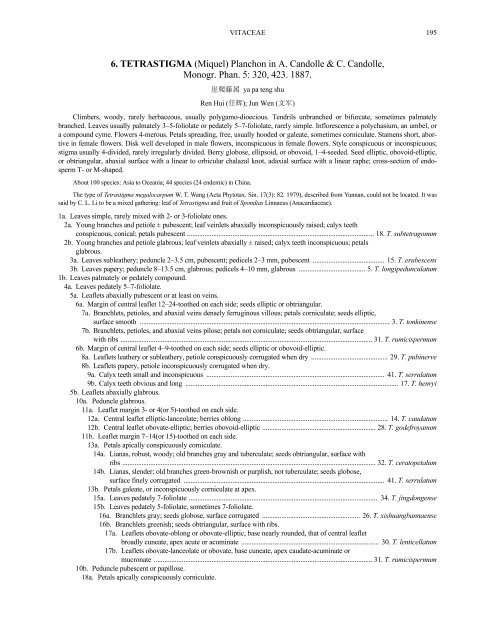VITACEAE 1. PARTHENOCISSUS Planchon in A. Candolle & C ...
VITACEAE 1. PARTHENOCISSUS Planchon in A. Candolle & C ...
VITACEAE 1. PARTHENOCISSUS Planchon in A. Candolle & C ...
You also want an ePaper? Increase the reach of your titles
YUMPU automatically turns print PDFs into web optimized ePapers that Google loves.
<strong>VITACEAE</strong><br />
6. TETRASTIGMA (Miquel) <strong>Planchon</strong> <strong>in</strong> A. <strong>Candolle</strong> & C. <strong>Candolle</strong>,<br />
Monogr. Phan. 5: 320, 423. 1887.<br />
崖爬藤属 ya pa teng shu<br />
Ren Hui (任辉); Jun Wen (文军)<br />
Climbers, woody, rarely herbaceous, usually polygamo-dioecious. Tendrils unbranched or bifurcate, sometimes palmately<br />
branched. Leaves usually palmately 3–5-foliolate or pedately 5–7-foliolate, rarely simple. Inflorescence a polychasium, an umbel, or<br />
a compound cyme. Flowers 4-merous. Petals spread<strong>in</strong>g, free, usually hooded or galeate, sometimes corniculate. Stamens short, abortive<br />
<strong>in</strong> female flowers. Disk well developed <strong>in</strong> male flowers, <strong>in</strong>conspicuous <strong>in</strong> female flowers. Style conspicuous or <strong>in</strong>conspicuous;<br />
stigma usually 4-divided, rarely irregularly divided. Berry globose, ellipsoid, or obovoid, 1–4-seeded. Seed elliptic, obovoid-elliptic,<br />
or obtriangular, abaxial surface with a l<strong>in</strong>ear to orbicular chalazal knot, adaxial surface with a l<strong>in</strong>ear raphe; cross-section of endosperm<br />
T- or M-shaped.<br />
About 100 species: Asia to Oceania; 44 species (24 endemic) <strong>in</strong> Ch<strong>in</strong>a.<br />
The type of Tetrastigma megalocarpum W. T. Wang (Acta Phytotax. S<strong>in</strong>. 17(3): 82. 1979), described from Yunnan, could not be located. It was<br />
said by C. L. Li to be a mixed gather<strong>in</strong>g: leaf of Tetrastigma and fruit of Spondias L<strong>in</strong>naeus (Anacardiaceae).<br />
1a. Leaves simple, rarely mixed with 2- or 3-foliolate ones.<br />
2a. Young branches and petiole ± pubescent; leaf ve<strong>in</strong>lets abaxially <strong>in</strong>conspicuously raised; calyx teeth<br />
conspicuous, conical; petals pubescent ........................................................................................................... 18. T. subtetragonum<br />
2b. Young branches and petiole glabrous; leaf ve<strong>in</strong>lets abaxially ± raised; calyx teeth <strong>in</strong>conspicuous; petals<br />
glabrous.<br />
3a. Leaves subleathery; peduncle 2–3.5 cm, pubescent; pedicels 2–3 mm, pubescent ......................................... 15. T. erubescens<br />
3b. Leaves papery; peduncle 8–13.5 cm, glabrous; pedicels 4–10 mm, glabrous ...................................... 5. T. longipedunculatum<br />
1b. Leaves palmately or pedately compound.<br />
4a. Leaves pedately 5–7-foliolate.<br />
5a. Leaflets abaxially pubescent or at least on ve<strong>in</strong>s.<br />
6a. Marg<strong>in</strong> of central leaflet 12–24-toothed on each side; seeds elliptic or obtriangular.<br />
7a. Branchlets, petioles, and abaxial ve<strong>in</strong>s densely ferrug<strong>in</strong>ous villous; petals corniculate; seeds elliptic,<br />
surface smooth ............................................................................................................................................... 3. T. tonk<strong>in</strong>ense<br />
7b. Branchlets, petioles, and abaxial ve<strong>in</strong>s pilose; petals not corniculate; seeds obtriangular, surface<br />
with ribs ................................................................................................................................................ 3<strong>1.</strong> T. rumicispermum<br />
6b. Marg<strong>in</strong> of central leaflet 4–9-toothed on each side; seeds elliptic or obovoid-elliptic.<br />
8a. Leaflets leathery or subleathery, petiole conspicuously corrugated when dry ............................................ 29. T. pub<strong>in</strong>erve<br />
8b. Leaflets papery, petiole <strong>in</strong>conspicuously corrugated when dry.<br />
9a. Calyx teeth small and <strong>in</strong>conspicuous ...................................................................................................... 4<strong>1.</strong> T. serrulatum<br />
9b. Calyx teeth obvious and long .......................................................................................................................... 17. T. henryi<br />
5b. Leaflets abaxially glabrous.<br />
10a. Peduncle glabrous.<br />
11a. Leaflet marg<strong>in</strong> 3- or 4(or 5)-toothed on each side.<br />
12a. Central leaflet elliptic-lanceolate; berries oblong ................................................................................... 14. T. caudatum<br />
12b. Central leaflet obovate-elliptic; berries obovoid-elliptic ................................................................. 28. T. godefroyanum<br />
11b. Leaflet marg<strong>in</strong> 7–14(or 15)-toothed on each side.<br />
13a. Petals apically conspicuously corniculate.<br />
14a. Lianas, robust, woody; old branches gray and tuberculate; seeds obtriangular, surface with<br />
ribs ................................................................................................................................................. 32. T. ceratopetalum<br />
14b. Lianas, slender; old branches green-brownish or purplish, not tuberculate; seeds globose,<br />
surface f<strong>in</strong>ely corrugated ................................................................................................................... 4<strong>1.</strong> T. serrulatum<br />
13b. Petals galeate, or <strong>in</strong>conspicuously corniculate at apex.<br />
15a. Leaves pedately 7-foliolate ............................................................................................................ 34. T. j<strong>in</strong>gdongense<br />
15b. Leaves pedately 5-foliolate, sometimes 7-foliolate.<br />
16a. Branchlets gray; seeds globose, surface corrugated ........................................................ 26. T. xishuangbannaense<br />
16b. Branchlets greenish; seeds obtriangular, surface with ribs.<br />
17a. Leaflets obovate-oblong or obovate-elliptic, base nearly rounded, that of central leaflet<br />
broadly cuneate, apex acute or acum<strong>in</strong>ate ............................................................................... 30. T. lenticellatum<br />
17b. Leaflets obovate-lanceolate or obovate, base cuneate, apex caudate-acum<strong>in</strong>ate or<br />
mucronate ............................................................................................................................. 3<strong>1.</strong> T. rumicispermum<br />
10b. Peduncle pubescent or papillose.<br />
18a. Petals apically conspicuously corniculate.<br />
195

















